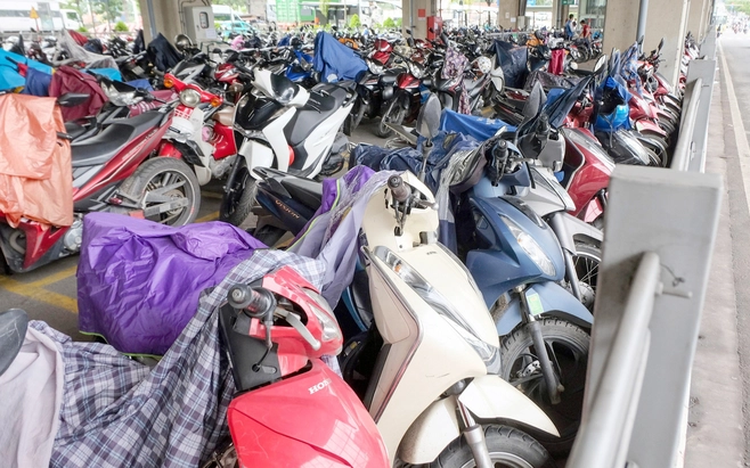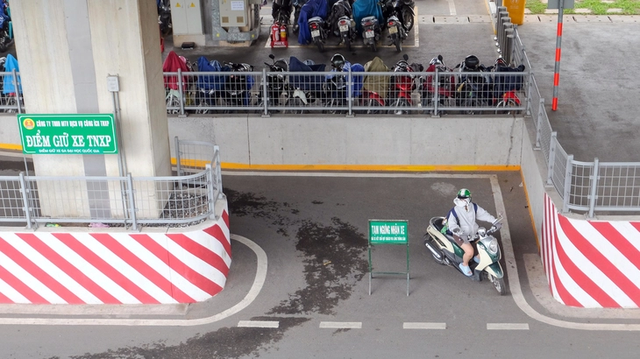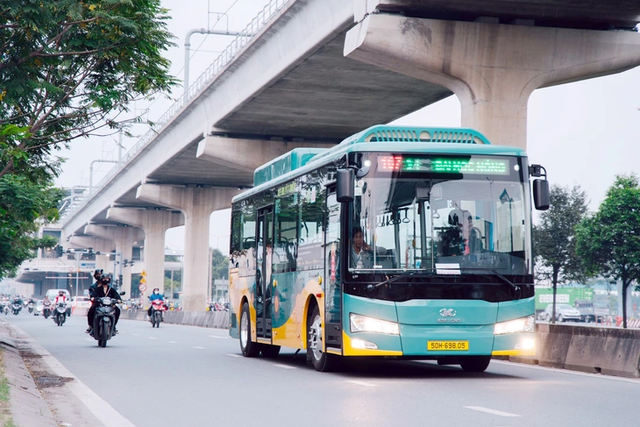
The parking lot near the Vietnam National University Station in Ho Chi Minh City is always full. Photo: Phuong Nhi / Tuoi Tre
In recent days, many riders arriving on motorbikes at metro stations have been unable to find parking spots. They have had to resort to parking at unofficial lots that charge much higher fees.
Authorities said they are seeking long-term solutions and encouraging people to use buses to access the metro.
Stations full early in the day
Most parking lots are full by early morning, especially at the Vietnam National University, Thu Duc, and the Hi-Tech Park stations.
Local residents and students park their motorbikes at those stations before heading into Ho Chi Minh City's core for study or work and the vehicle number is huge.
At around 9:00 am on September 27, at the lot beneath the Vietnam National University metro station, a sign reading "No more parking" was posted.
Many motorbike riders who arrived saw the sign and left to look for other places to leave their vehicles.
When one bike exited the lot, attendants immediately let another bike in, so the lot remained full. Since these lots have limited size and capacity, they frequently reach maximum occupancy.
Private lots charge more
Meanwhile, small unofficial parking lots run by private individuals have popped up around the Vietnam National University station. They charge about VND10,000 (US$0.4) per entry, more than double the rate of the official lot at VND4,000 ($0.15) per entry.

Metro riders in Ho Chi Minh City leave disappointed by the "No more parking" sign. Photo: P. Nhi / Tuoi Tre
These lots are just a few dozen square meters, with a capacity of 20 to 30 bikes each, and basic safety conditions. After 9:00 am, even these lots quickly become full and refuse further parking.
This same issue occurs at many other stations along Metro Line No. 1, particularly on weekday mornings when commuter traffic into the city center peaks and securing a parking spot becomes stressful.
By contrast, parking lots located along the parallel road with Hanoi Highway remain relatively underused.
Users of these lots are often tourists or people visiting the metro for experience or sightseeing, not regular commuters or students, since those lots are along the outward direction from the city center.
Riders weigh options
Thanh Ngan, a 28-year-old resident in Linh Xuan Ward, said she works in the city center. Since the metro began operations, she has ridden her motorbike to the Vietnam National University Station, parked there, then taken the metro to Ben Thanh Station.
"The parking lot at the Vietnam National University is usually full very early, by 7:00 am to 8:00 am. I'm reluctant to use private lots charging VND10,000 [$0.4] because they're overpriced and I worry about safety or fire risk.
"If something goes wrong, no one will compensate, and I might lose my bike," she explained. "So on days when I can't park, I just ride straight to work on my motorbike."
Some Metro Line No. 1 passengers believe that to better accommodate riders and reduce use of personal vehicles in the city center, authorities should expand station parking capacity and regulate unsafe, high fee informal lots, which discourage people from using the metro due to added costs.
Nguyen Van Vinh, a frequent metro user, shared that early on he tried parking his motorbike at the station before taking the train downtown. After two or three weeks, he found the parking lots always full. People queued and circulated trying to find parking, wasting time and money.
Later, he discovered bus route 153 from Binh An Water Bus Terminal to Lien Phuong Street passes near his home and connects directly to the metro station. He now walks 10 minutes to that bus stop and then rides to the station, which is convenient and comfortable.
"In my view, the local agencies should first add more parking points to cover demand from cyclists and motorbike users. More importantly, we need outreach to encourage people to take buses to metro stations," Vinh suggested.
This can be considered a long term and sustainable solution. It contributes to changing people's commuting habits and significantly reduces the use of personal vehicles. Moreover, I personally find taking the bus to the metro quite convenient, comfortable, and cost effective.
"To achieve this, Ho Chi Minh City needs to review and properly plan the bus network routes to effectively connect with the metro, and increase incentive programs for students," Vinh suggested.
According to Ho Chi Minh City Urban Railways No. 1 Company Limited, the Metro Line No. 1 operator, since early this year, the metro has carried 13.7 million passengers. The parking demand is enormous, and vehicles staying parked all day leads to severe overcapacity.
The company is aware of the problem and has discussed with Voluntary Youth Public Benefit Service Company Limited proposals to expand or add new lots soon.
For underground stations like Ben Thanh, Opera House, and Ba Son, passengers may use nearby parking lots in commercial centers, parks, or adjacent facilities.
Bus-to-metro connection
On September 28, Le Hoan, deputy director of the Ho Chi Minh City Public Transportation Management Center under the Department of Construction, said the agency is working with partners to review and reorganize bus routes connecting to Metro Line No. 1 to maximize convenience. The goal is to encourage riders to take buses to the metro.
So far, the city has launched 17 electric bus routes directly linked to metro stations. In addition, several indirect bus routes have been rerouted to pass by metro stations, such as routes Nos. 33, 55, 150, and 89.

An electric bus route connecting to Metro Line No. 1 in Ho Chi Minh City. Photo: Thanh Hiep / Tuoi Tre
Some of these have seen strong public support, while others are still gaining popularity.
"We're continuing to monitor and adjust based on rider demand to better organize bus services. Attractive incentives for combined bus and metro riders will also be rolled out," Hoan said.
However, the bus-to-station connection is still not ideal. At stations along Vo Nguyen Giap Street and Hanoi Highway, parking lots are located on either side of the road.
Lots on one side for vehicles traveling from Ben Thanh toward Suoi Tien remain relatively empty, while those on the opposite side are often full.
The two lots are connected by a pedestrian overpass but riders do not park at the emptier lot and walk over as many choose the fastest route, park right at the station and hop on the train.
The three-kilometer motorbike ride to the station takes five to seven minutes, but taking a bus, including waiting, might cost 20 to 25 minutes and risk traffic delays. Many riders switch to motorbike rides after arriving at the station instead of using a connecting bus.
To improve, the city must further facilitate bus-metro connectivity. Though 17 routes exist, narrow streets and encroachments slow buses, making them less appealing even though buses themselves are new, clean, and efficient.
Traffic planners must clear obstructions and make routes more reliable so that buses become a more attractive option.
In heavily congested station areas like the Vietnam National University, while buses are still ramping up, authorities should consider expanding existing parking lots or adding new ones nearby.


Max: 1500 characters
There are no comments yet. Be the first to comment.